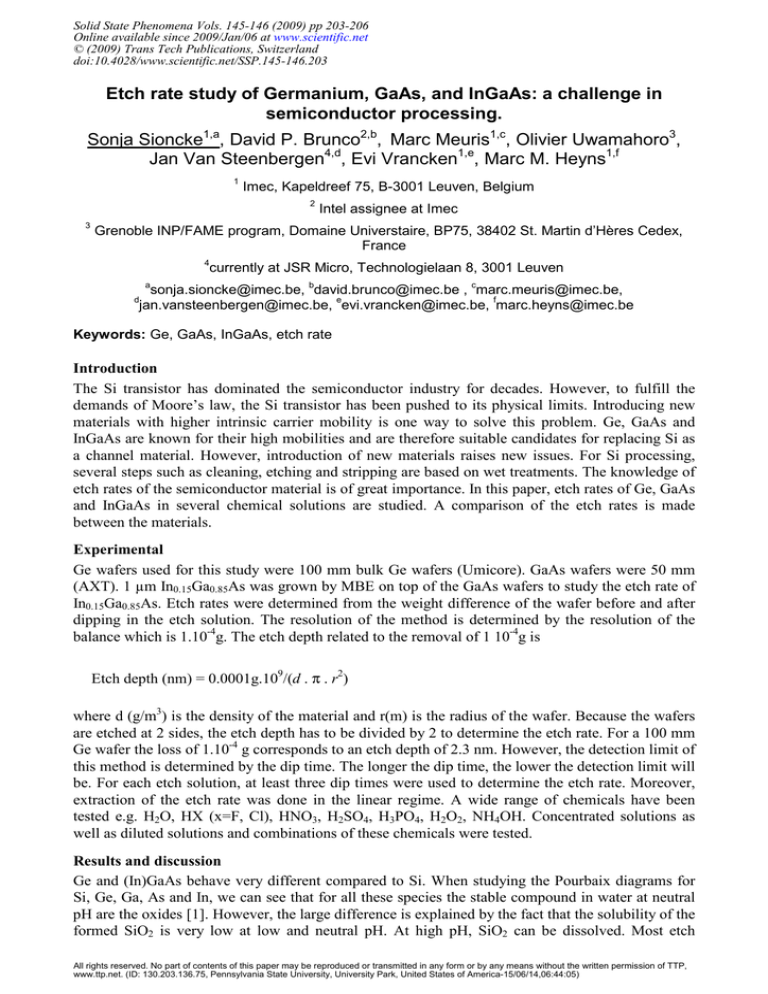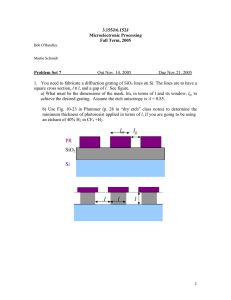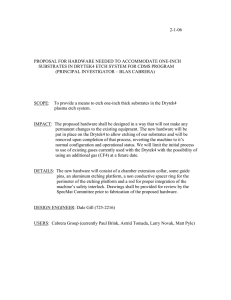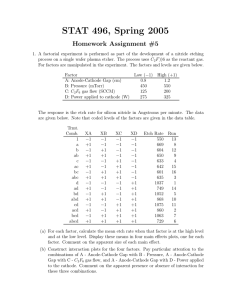
Solid State Phenomena Vols. 145-146 (2009) pp 203-206
Online available since 2009/Jan/06 at www.scientific.net
© (2009) Trans Tech Publications, Switzerland
doi:10.4028/www.scientific.net/SSP.145-146.203
Etch rate study of Germanium, GaAs, and InGaAs: a challenge in
semiconductor processing.
Sonja Sioncke1,a, David P. Brunco2,b, Marc Meuris1,c, Olivier Uwamahoro3,
Jan Van Steenbergen4,d, Evi Vrancken1,e, Marc M. Heyns1,f
1
Imec, Kapeldreef 75, B-3001 Leuven, Belgium
2
3
Intel assignee at Imec
Grenoble INP/FAME program, Domaine Universtaire, BP75, 38402 St. Martin d’Hères Cedex,
France
4
currently at JSR Micro, Technologielaan 8, 3001 Leuven
a
b
c
sonja.sioncke@imec.be, david.brunco@imec.be , marc.meuris@imec.be,
d
jan.vansteenbergen@imec.be, eevi.vrancken@imec.be, fmarc.heyns@imec.be
Keywords: Ge, GaAs, InGaAs, etch rate
Introduction
The Si transistor has dominated the semiconductor industry for decades. However, to fulfill the
demands of Moore’s law, the Si transistor has been pushed to its physical limits. Introducing new
materials with higher intrinsic carrier mobility is one way to solve this problem. Ge, GaAs and
InGaAs are known for their high mobilities and are therefore suitable candidates for replacing Si as
a channel material. However, introduction of new materials raises new issues. For Si processing,
several steps such as cleaning, etching and stripping are based on wet treatments. The knowledge of
etch rates of the semiconductor material is of great importance. In this paper, etch rates of Ge, GaAs
and InGaAs in several chemical solutions are studied. A comparison of the etch rates is made
between the materials.
Experimental
Ge wafers used for this study were 100 mm bulk Ge wafers (Umicore). GaAs wafers were 50 mm
(AXT). 1 µm In0.15Ga0.85As was grown by MBE on top of the GaAs wafers to study the etch rate of
In0.15Ga0.85As. Etch rates were determined from the weight difference of the wafer before and after
dipping in the etch solution. The resolution of the method is determined by the resolution of the
balance which is 1.10-4g. The etch depth related to the removal of 1 10-4g is
Etch depth (nm) = 0.0001g.109/(d . π . r2)
where d (g/m3) is the density of the material and r(m) is the radius of the wafer. Because the wafers
are etched at 2 sides, the etch depth has to be divided by 2 to determine the etch rate. For a 100 mm
Ge wafer the loss of 1.10-4 g corresponds to an etch depth of 2.3 nm. However, the detection limit of
this method is determined by the dip time. The longer the dip time, the lower the detection limit will
be. For each etch solution, at least three dip times were used to determine the etch rate. Moreover,
extraction of the etch rate was done in the linear regime. A wide range of chemicals have been
tested e.g. H2O, HX (x=F, Cl), HNO3, H2SO4, H3PO4, H2O2, NH4OH. Concentrated solutions as
well as diluted solutions and combinations of these chemicals were tested.
Results and discussion
Ge and (In)GaAs behave very different compared to Si. When studying the Pourbaix diagrams for
Si, Ge, Ga, As and In, we can see that for all these species the stable compound in water at neutral
pH are the oxides [1]. However, the large difference is explained by the fact that the solubility of the
formed SiO2 is very low at low and neutral pH. At high pH, SiO2 can be dissolved. Most etch
All rights reserved. No part of contents of this paper may be reproduced or transmitted in any form or by any means without the written permission of TTP,
www.ttp.net. (ID: 130.203.136.75, Pennsylvania State University, University Park, United States of America-15/06/14,06:44:05)
204
Ultra Clean Processing of Semiconductor Surfaces IX
solutions for Si are therefore based on alkali solutions. On the other hand HF is also able to dissolve
Si and the second class of Si etchants is based on HF containing solutions. However, Ge and
(In)GaAs form oxides which are water soluble. This results in much higher etch rates when using
the same solutions as for Si. Therefore, a careful design of the etch solution is needed. In the first
part we will focus on the etch rates of Ge and (In)GaAs in APM and HPM solutions. In the second
part, etch rates for Ge and (In)GaAs will be compared.
Etch rates for Ge and (In)GaAs in APM (H4OH/H2O2/H2O) and HPM (HCl/H2O2/H2O). The
RCA Standard Clean 1 (SC1) consists of (NH4OH/H2O2/H2O) at a 1/1/5 ratio and at a temperature
of 75-80ºC for 10 min [2,3]. This SC1 solution and its variants [4] are widely used for removal of
particles, organics and certain metals from the Si surface. This solution etches Si at a rate of 0.82
nm/min. Using the same solution for Ge at room temperature would remove 275.5 nm/min. For
GaAs, the etch rate is even higher (~2 µ/min). The RCA Standard Clean 2 (SC2), consists of
HCl/H2O2/H2O at a 1/1/6 ratio and is used at a temperature of 75-80ºC for 10 min [2,3]. An HPM
solution with comparable composition 1/1/7 is etching Ge at a rate of ~200 nm/min. Therefore, we
investigated the etch rates of more diluted APM and HPM solutions.
The results are plotted in Figure 1. The etch rates of APM and HPM solutions are plotted as a
function of volume fraction of 30wt%-H2O2. The drawn lines serve as a guide to the eye. It is clear
that the etch rate increases when the volume fraction of H2O2 is increased. This is the case for both
Ge and (In)GaAs. A second observation is that the pH is not playing a major role in the etch rate.
Using HCl for the HPM solutions or NH4OH for the APM solutions is not influencing the etch rate.
For both graphs, 1 data point was added for an SPM (4 H2SO4/1 H2O2) solution. Replacing HCl by
H2SO4 also does not influence the etch rate. However, removing the complexing agent (HCl,
NH4OH or H2SO4) gives a different trend. For Ge, data points for solutions only containing H2O2
were added. We clearly see that the etch rate is increasing with the H2O2 fraction but the slope is
less steep compared to the APM or HPM solutions. Also, some data points of the APM and HPM
solutions are positioned rather on the curve of the H2O2 solutions. These solutions typically have
low ratios of NH4OH or HCl to H2O2 and therefore behave more like the H2O2 solutions without
complexing agent (the compositions of these solutions were 1/1000/50000 for both APM and HPM
solutions).
For (In)GaAs, the situation is even more pronounced. The solutions without complexing agents are
not etching the wafers (therefore, we didn’t include them in the graph). We can conclude that the
etch rates for both Ge and (In)GaAs are independent of the class of complexing agent (base or acid).
On the other hand, a minimum amount of complexing agent is needed to dissolve the formed
oxides. In the case of Ge, the absence of the complexing agent decreases the etch rate. In the case of
(In)GaAs, the etch rates drops to zero. The difference between Ge and (In)GaAs can be explained by
the fact that the solubilities of Ga- and In-oxides are much lower than for Ge at neutral pH values
and the addition of a complexing agent is therefore more crucial to observe a detectable etch rate.
A last observation is the fact that the etch rates are very high. The highest etch rates for Ge in the
graph are corresponding to APM solutions with a ratio of 1/1/5 and 1/4/20 and to the HPM solution
with a ratio of 1/1/7. To replace the 1/1/5 APM solution that has been widely used for particle
removal from Si, we would propose the 1/1/5000 APM solution. This solution is etching Ge at a
rate of ~5 nm/min. The pH is 10.6 which is high enough to prevent particle redeposition [5]. This
solution could also be used for cleaning of GaAs as it etches 2 nm/min. HPM solutions that can be
used for the removal of metals from the semiconductor surface could also be designed with slower
etch rates. However, we have seen that using slowly etching HPM solutions cannot prevent
redeposition of metals on the Ge surface. Only fast etching HPM solutions were able to remove
most metals. HF solutions have been also tested for metal removal and this would be a suitable
solution to remove metals from the Ge surface [6]. For GaAs, the digital etch (H2O2/H2O ½ for 10
min followed by HCl/H2O 1/1 for 1 min) proposed by DeSalvo et al. [7] is removing 1.5 nm per
Solid State Phenomena Vols. 145-146
205
cycle and is able to remove the metallic contamination. Therefore, this two-step etching process
could be used as an alternative to HPM solutions.
Comparison of etch rates for Ge, GaAs and InGaAs. As already mentioned, the high etch rates of
Ge are related to the high solubility of GeO2 in water. For GaAs and InGaAs, we see the same
trends. (In)GaAs-oxides are more soluble in water compared to Si. However, we have to make a
distinction between As-oxides and Ga-oxides and In-oxides. As-oxides are highly soluble and the
solubility is increasing by increasing or decreasing the pH. On the other hand, In- and Ga-oxides are
more difficult to dissolve but the same principle applies as to the As-oxides: the solubility increases
by increasing or decreasing the pH. The etch rates for GaAs and In0.15Ga0.85As are higher in acid
containing solutions than for Ge (Figure 2A). This could be explained by the fact that solubilities of
As-oxides or increasing by lowering the pH. However this effect is more pronounced for the Ga-and
In-oxides: a steep increase of the solubility can be seen by lowering the pH (Figure 3). On the other
hand, lowering the pH has no influence on the solubility of Ge-oxides. This hypothesis is only on
the assumption that these etch rates are reaction limited rather than diffusion limited. The diluted
H2O2 solution is the exception. The etch rate for Ge is higher than for GaAs and In0.15Ga0.85As.
Moreover, the etch rates are close to 0 nm/min in H2O2 containing solutions for GaAs and
In0.15Ga0.85As. Even in concentrated (30 wt%) H2O2 the etch rate of (In)GaAs is around the
detection limit.
In Figure 2B, the etch rates for Ge, GaAs and In0.15Ga0.85As in APM solutions are shown. Here, we
observe the opposite trend as for the acidic solutions (except for the 1/1/5 solution). The etch rates
for (In)GaAs are lower than for Ge in APM solutions. Again, we could explain this by the fact that
in this case all the solubilities are increasing by increasing the pH. However, in the pH region of the
APM solutions (between 9.8 and 10.6) the Ge-oxides are still more soluble than the In- and Gaoxides. This could explain the fact that most etch rates for Ge are higher in APM solutions. Again,
we have to make the assumption that the etch rates are reaction limited.
Summary
An etch rate study is presented on advanced semiconductor materials such as Ge, GaAs and
In0.15Ga0.85As. As these materials have unstable oxides in water, etch rates are much higher than for
similar solutions used for Si processing. Therefore more diluted versions of SC-1 should be used
and SC-2 should be replaced by other solutions. Also, SPM which is used for removal of organic
contaminants should be replaced by other solutions as high etch rates are observed.
References
[1] M. Pourbaix, Atlas of Electrochemical Equilibria in Aqueous Solutions, (NACE International Cebelcor, Houston
(TX), 2nd English Edition 1974).
[2] W. Kern, Handbook of Semiconductor Wafer Cleaning Technology, (Noyes Publications, New Jersey, 1993).
[3] W. Kern, J. Electrochem. Soc., 137, (1990), p1887.
[4] M. Itano, F.W. Kern Jr., M. Miyashita, and T. Ohmi, IEEE Trans. Semiconduct. Manufact., 6, (2005), p220.
[5] S. Sioncke, M. Lux, W. Fyen, M. Meuris, P. Mertens, and A. Theuwis, 8th International Symposium on Ultra Clean
processing of Semiconductor Surfaces (UCPSS), Antwerp, Belgium, 2006.
[6] S. Sioncke, B. Onsia, K. Struys, J. Rip, R. Vos, M. Meuris, P. Mertens, and A. Theuwis, ECS Trans. 1, 220 (2005).
[7] G. C. DeSalvo et al., J. Electrochem. Soc., 143 (11), (1996), p3652.
206
Ultra Clean Processing of Semiconductor Surfaces IX
GaAs/APM
In0.15Ga0.85As/APM
GaAs/HPM
In0.15Ga0.85As/HPM
GaAs/SPM
In0.15Ga0.85As/SPM
10000
Ge
etch rate (nm/min)
etch rate (nm/min)
1000
100
10
APM
HPM
H2O2
SPM
1
0.01
0.1
100
10
(In)GaAs
1
0.0001
0.1
1E-05 0.0001 0.001
1000
1
0.001
0.01
0.1
1
volume fraction 30%-H2O2
A
Figure 1: Etch rate (nm/min) as a function of volume fraction of H2O2 for Ge (A) and (In)GaAs (B) for APM and HPM
solutions. Solutions only containing H2O2 are also included. Both for Ge and (In)GaAs, 1 point is included for SPM (4
H2SO4/1 H2O2). The drawn lines are used as a guide to the eye.
volume fraction 30%-H2O2
Ge
10000
GaAs
In0.15Ga0.85As
1.00E+04
1.00E+03
1.00E+02
1.00E+01
(1
/1
/1
H2
)
O
2/
H2
O
(1
H2
/1
0)
SO
4/
H
2O
2
(4
/1
)
100
10
1/
50
00
0
1/
1/
10
/5
00
50
/1
/
10
/5
1/
0
00
5
1/
1/
HN
HF
/
1000
1
O
3/
H2
O
O
3
(3
/1
)
(3
/1
)
HC
l/H
N
NO
3
H3
PO
4/
H
HC
l/H
2O
2/
H2
O
(1
/1
0/
50
00
)
1.00E+00
Ge
GaAs
In0.15Ga0.85As
APM
10
Etch rate (nm/min)
1.00E+05
etch rate (nm/min)
1.00E+06
A
Figure 2: Etch rates of Ge, GaAs and In0.15Ga0.85As in acid containing solutions (A) and APM solutions (B). The ratio of
the APM mixture (NH4OH/H2O2/H2O) is indicated on the axis. If no bar is indicated, the etch rate was not determined.
GeO2
As2O3
Ga2O3
In2O3
-log (soluble species)
20
15
10
5
0
-5
-10
-15
-2
0
2
4
6
8
10
12
B
14
pH
Figure 3: Solubilities of Ge, As, Ga and In oxides as a function of the pH of the solution.
B
Ultra Clean Processing of Semiconductor Surfaces IX
10.4028/www.scientific.net/SSP.145-146
Etch Rate Study of Germanium, GaAs and InGaAs: A Challenge in Semiconductor Processing
10.4028/www.scientific.net/SSP.145-146.203
DOI References
[3] W. Kern, J. Electrochem. Soc., 137, (1990), p1887.
doi:10.1149/1.2086825
[6] S. Sioncke, B. Onsia, K. Struys, J. Rip, R. Vos, M. Meuris, P. Mertens, and A. Theuwis, ECS Trans. 1,
220 (2005).
doi:10.4028/www.scientific.net/SSP.103-104.27
[7] G. C. DeSalvo et al., J. Electrochem. Soc., 143 (11), (1996), p3652. e
doi:10.1149/1.1837266




